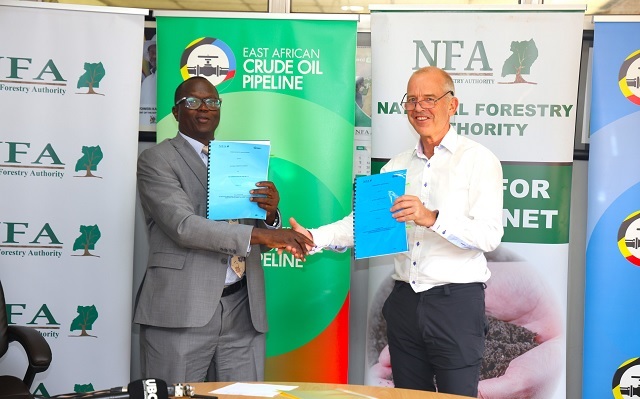
Kampala, Uganda | THE INDEPENDENT | In line with EACOP’s environmental mitigation and conservation requirements, EACOP has signed a Memorandum of Understanding with the Ugandan National Forestry Authority (NFA) to facilitate the continued partnership between the two entities for biodiversity conservation and natural resource management where their areas of interest coincide.
The EACOP route traverses a section of Taala Central Forest Reserve used mainly for eucalyptus forestry, and this MOU provides a mechanism for collaboration between EACOP and NFA for the improvement of biodiversity conservation in the area as well as other forestry conservation initiatives as agreed upon.
Martin Tiffen, the managing director, EACOP said, “EACOP is committed to meeting the International Finance Corporation (IFC) Performance Standards including the International Best Practice methodology of ‘avoid, minimize, restore, offset’ concerning the environment in areas where direct and indirect impacts may occur during the pipeline development and operations. The company has put in place measures that will be implemented during and after the construction of the pipeline to restore and enhance the environment. Among the planned interventions are biodiversity offsets which the Company will work with mandated government institutions like the NFA to support successful implementation.”
Tom Obong Okello, the executive director, NFA said, “NFA and EACOP have previously worked together during the planning phase of the project for example during the assets valuation process of the resettlement action planning where they identified and enumerated trees in the projects’ footprint. This information will form the basis of EACOP’s reinstatement and tree replanting programs.”
The US$4bn EACOP is a buried pipeline system that will transport crude oil produced from the Tilenga and Kingfisher developments in Uganda’s Lake Albert area to world markets. The pipeline starts in Kabaale – Hoima in Uganda and ends on the Chongoleani peninsula near Tanga on the Indian ocean coast in Tanzania. This major export system includes 1,443 km (296 km in Uganda and 1147km in Tanzania).
 The Independent Uganda: You get the Truth we Pay the Price
The Independent Uganda: You get the Truth we Pay the Price



